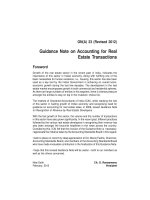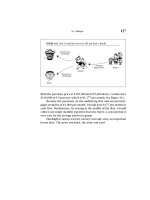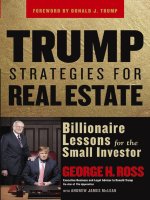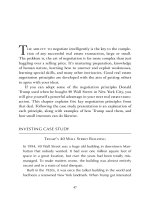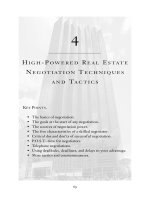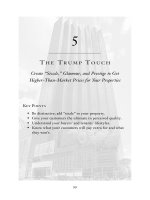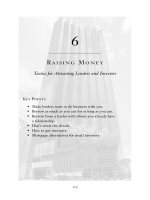TRUMP STRATEGIES FOR REAL ESTATE CHAPTER 3 pdf
Bạn đang xem bản rút gọn của tài liệu. Xem và tải ngay bản đầy đủ của tài liệu tại đây (427.12 KB, 22 trang )
47
T
HE ABILITY TO
negotiate intelligently is the key to the comple-
tion of any successful real estate transaction, large or small.
The problem is, the art of negotiation is far more complex than just
haggling over a selling price. It’s mastering preparation, knowledge
of human nature, learning how to uncover and exploit weaknesses,
learning special skills, and many other intricacies. Good real estate
negotiation principles are developed with the aim of getting others
to agree with your ideas.
If you can adopt some of the negotiation principles Donald
Tr ump used when he bought 40 Wall Street in New York City, you
will give yourself a powerful advantage in your next real estate trans-
action. This chapter explains five key negotiation principles from
that deal. Following the case study presentation is an explanation of
each principle, along with examples of how Trump used them, and
how small investors can do likewise.
INVESTING CASE STUDY
T
RUMP
’
S
40 W
ALL
S
TREET
B
UILDING
In 1994, 40 Wall Street was a huge old building in downtown Man-
hattan that nobody wanted. It had over one million square feet of
space in a great location, but over the years had been totally mis-
managed. To make matters worse, the building was almost entirely
vacant and in a state of total disrepair.
Built in the 1920s, it was once the tallest building in the world and
had been a renowned New York landmark. When Trump got interested
TRUMP STRATEGIES FOR REAL ESTATE
48
in the property, and asked me to handle the acquisition for him, the
land on which the building was built was owned by a wealthy German
family who had granted a long-term lease to a bank that had built the
building as its headquarters.
Unfortunately, the building had a very troubled past with many
building operators. At one time, Ferdinand Marcos, the infamous pres-
ident of the Philippines owned it, and during his tenure the building
was run into the ground. Eventually, it went into foreclosure and was
sold to a member of the Resnick family who had loads of real estate
experience, but who still couldn’t make it work. He let it go into fore-
closure and the holder of the mortgage took it back. Then it went to
Kinson Group out of Hong Kong. They put millions of dollars into it,
but they also failed dismally. Nobody seemed able to come up with a
plan that could transform 40 Wall Street from a loser to a winner.
The underlying problem was that the ground lease (the lease for the
land on which the building was built) was antiquated and contained
provisions that were hostile to potential occupants, making it difficult
for anyone to finance a purchase of the lease or needed building ren-
ovations. Although they tried, none of the previous owners could ever
get the ground lease modified to eliminate the deficiencies it con-
tained. Percy Pyne was the man who represented the German prop-
erty owner, and nobody was able to bypass him in order to negotiate
directly with the owner. Pyne was a difficult man to deal with and
continually placed unacceptable obstacles in the way of every deal
that was proposed.
While the Kinson group poured millions of dollars into the prop-
erty, they also forced most tenants out of the building, leaving it al-
most vacant, except for a law firm that occupied seven floors on a
long-term lease. Kinson left the building with virtually no services
and in terrible shape, and to make matters worse, their failure to pay
contractors resulted in the filing of several mechanic liens adding up
to almost a million dollars against the building. Since there was no
P
RINCIPLES OF
N
EGOTIATION
49
40 Wall Street
TRUMP STRATEGIES FOR REAL ESTATE
50
better alter
native, the Kinson group agreed that it would give Trump
an option to buy the building for $1 million. (The huge building was
one million square feet, which meant Trump could buy the building for
a dollar per square foot—a ridiculously low price.) Trump also as-
sumed liability for the $1 million of liens.
Tr ump realized he could never make a deal with Percy Pyne, so in
a stroke of pure genius he flew to Germany and met directly with the
owner of the property. He was following one of the basic principles
that good salespeople know—find a way to get around the gate-
keeper and talk directly to the decision maker.
Tr ump t old t he ow ner, “If you work with me and give me a fair
ground lease, I will make 40 Wall Street a very successful building
that you will be proud of. But, he added, I can’t pay you any rent for
at least a year while I am renovating the building. I know you have
had a parade of failing tenants but I guarantee I won’t join the list.”
Tr umpwon over theowner,who agreed to rewrite the lease to make
it financeable and feasible for either an office or residential building.
Part of what Trump loved about this deal was thefactthatno one
else had been able to make the building work. He loved the chal-
lenge. What made it even more enticing was the location: it had won-
derful viewsofthe NewYorkHarborand fantastic potential. Also,
Tr ump thought the rental market would turn around, the building was
huge, and where intheworldcouldyoubuyaprime-locatedoffice
buildingfor $1 a square foot even with all its problems? It’s unheard
of. Even though in 1996, the downtown New York City area was still
adisaster,Trumpexercisedtheoptiontobuy40WallStreet.
Tr ump had an advisor named Abe Wallach who played an instru-
mental role in the purchase of 40 Wall Street and was of the opinion
that it could never be successful as an office building. He thought the
only feasible solution was a conversion into residential co-operative
apartments. At this particular time, there was a glut of office space,
and in fact, the city was offering developers incentives to convert
vacant office space in the downtown area to residential units. So
P
RINCIPLES OF
N
EGOTIATION
51
Tr ump said to me, “George, I’m thinking of turning 40 Wall Street
into co-op units, because that’s what everybody else is doing. I
want you to analyze the situation and tell me what you think I
should do.”
A number of well-known brokers had analyzed the building and
determined that there were no tenants looking for office space down-
town. They said that even if the office rental market improved, the
higher floors were too small to be attractive, and the lower floors
contained huge columns that interfered with efficient space usage.
Their sentiments were unanimous: “It will never work as an office
building even if by some miracle the market for downtown office
space improves.”
But there was a major roadblock to residential conversion. Before
any workcouldbecommencedadealwouldhavetobemadewith
theseven-floor law firm to give up their lease. Based on my exten-
sive experience in dealing with holdouts and knowing the principals
of the law firm, I knew this would be a time-consuming and expen-
sive settlement.
Not satisfied with the advice of others to turn the building into co-
op apartments, I did my own analysis and about a week later I went to
Donald and said, “I studied the best use of the building and came to
the conclusion that it actually can work as an office building. The ex-
perts have been taking the wrong approach and reached the wrong
conclusion. You don’t have one office building, you have three. They
just happen to be on top of each other. You have 400,000 square feet
of small office space on the top portion of the building. I don’t care
what the others say; I think that’s rentable at $17 per square foot
(which was $2 per square foot over the average market rent) because
a tenant will have the prestige of renting an entire floor, and a fantas-
tic view of New York harbor.”
IalsotoldhimthatIworked out the financial projections based on
his total cost of acquisition and renovation. I concluded that: “If we
cantake the 400,000 square feet at the top of the building and rent it
TRUMP STRATEGIES FOR REAL ESTATE
52
for $17 per square foot, you’ll break even. On the next 300,000 square
feet going down, the floorsarelarger, so even without the views we
should still be able to average $17 a square foot in rent. If I can do that,
youwillmake a profit. As for the bottom 300,000 square feet, it
doesn’tmatter if you never rent it as office space. You’re in so cheap
at $1 per square foot; it won’t make any difference what you do with it
so long as you can cover the cost of renovation for an occupant.”
Ioutlinedmygameplan:“Firstyou’llhavetodoatotalmakeover
of the lobby to make it luxurious, à la Trump style. Second you’ll have
to renovate the infrastructure to bring it all up to state of the art. This
will include the elevators, air conditioning, electrical, and plumbing
systems. Third, to be competitive with more modern buildings, all of
the latest telecommunication and data systems must be installed and
available for tenants. If you agree to do that, I’ll do the leasing.” Trump
replied, “George,makeithappen.”
Tr ump borrowed $35 million from Union Labor Life Insurance
Company to be used for renovations. They loved the idea of renovat-
ing this building because it would put many of their union members
back to work. They even stipulated that only union members could
be used in construction or renovation. Although the loan was for $35
million, it wasn’t nearly enough if we signed tenants and made the
improvements that would be required. I told Trump: “If the building is
a huge success, it’s a terrible loan but if the building bombs, it’s a
great loan.” Nevertheless, based on the past history of failures with
the building and the economic climate at that time, it was the only
loan Trump could get at that time.
I settled the mechanic liens that existed on the building (almost $1
million) for $60,000. I told all the parties that had the liens, “Look,
there’s no way you’re going to get paid the amount of your claims. But
I will give you first crack at renovation work on the building if you give
up your liens.” Most of them agreed to it, and I gave them an opportu-
nity to bid on the work.
P
RINCIPLES OF
N
EGOTIATION
53
Tr ump successfully refurbished the building and I started leasing it.
The first lease I made was with a major financial firm at a rental of
$23 a square foot—far higher than the $17 per square foot I had pro-
jected. The building had assumed the mantle of credibility and
achieved the recognition of superiority that Trump ownership con-
notes. As the market rebounded and the building became extremely
popular, I rented 400,000 square feet at $24 per square foot on the
lower floors to American Express. Later on I rented another 400,000
feet to Continental Casualty Co. at a good rental number. With the
influx of tenants Trump replaced the original mortgage with a huge
mortgage at a very reasonable interest rate. I’m still involved in leas-
ing and managing it, and today the building, which he bought for $1
million, is worth between $340 and $400 million. It’s called the
Tr ump Building and it’s a tremendous success.
I
NSIST ON
N
EGOTIATING
D
IRECTLY WITH THE
D
ECISION
M
AKER
, N
OT A
R
EPRESENTATIVE
Tr ump’s style of negotiation is face-to-face. He rarely lets others ne-
gotiate for him. In the Commodore-Hyatt deal described in Chapter
1, Trump negotiated directly with Jay Pritzker, the CEO of the
Hyatt Company. But not before spinning his wheels with no results
trying to negotiate with Pritzker’s underlings. Learn from his early
mistake, and as a general rule, don’t let others negotiate on your be-
half. If you want credibility, do it yourself. Meet important people.
Go to the highest level, the decision maker. That was the break-
through for Trump with 40 Wall Street.
Tr u mp’s instincts were that the ground lease owner of 40 Wall
Street could not be as bad a businessman as he was portrayed to be.
The man obviously would want a good tenant in the property. Yet,
the building was in disrepair and barely occupied, the rent wasn’t
TRUMP STRATEGIES FOR REAL ESTATE
54
being paid, and Percy Pyne created the impression that the ground
lease owner was unreachable and all negotiations had to be done with
him. Listening to Pyne, one would believe that, in fact, he was speak-
ing for the owner.
Tr ump’s instinct was that if he wanted to make the deal, he had to
get to the owner and talk to him directly, to see whether or not some-
thing was being lost in the translation from Percy Pyne. He couldn’t
believe that a foreign owner of real estate would tolerate this property
in its present condition. So he got on a plane and flew to Germany to
meet directly with the ground lease owner. There he was able to es-
tablish a working relationship of mutual trust that led to successfully
negotiating a new ground lease that satisfied both parties. In fact,
Tr ump’s relationship with the landowner was so good that while
Tr u mp was refurbishing the building (at greater expense than origi-
nally planned), Trump asked the owner to waive the rent for a second
year. The owner agreed because he was so thrilled with all the work
that was going on to make it a first-class building. The waiver saved
Tr ump another $1.5 million in rent. So, by the time Trump had to
start paying rent on the ground lease, he had a rental income suffi-
cient to cover all his obligations. As we discussed in Chapter 1, suc-
cessful, long-term real estate investing is always based on building
good personal relationships with the key people involved.
The 40
Wal l St reet deal has a lot to teach small real estate investors about
negotiation. Following are explanations of five key principles that
Tr ump used to turn around 40 Wall Street, and how you can use
them in your real estate transactions.
P
RINCIPLE
1: C
REATE THE
A
URA OF
E
XCLUSIVITY
One of the most fundamental principles of human nature is that peo-
ple want something that everyone else wants or no one else has. If
P
RINCIPLES OF
N
EGOTIATION
55
you tell someone that a property you own is not for sale there is a
good chance they will want it even more. They may even hound you
until you name a price. The simple statement that something is a
limited edition creates a desire for ownership. For example, the suc-
cess of any auction sale depends on the number of bidders and the
emotional frenzy of a heated bidding environment. Because every
parcel of real estate and every building is unique in some way, the ex-
clusivity principle is already at work to drive up the price, but you
can get a much higher price, if you can create more exclusivity for
your property. Later chapters explain in more detail how Trump does
this, but you can create the aura of exclusivity by the way you talk up
the features of any property: its location, size, neighborhood, in-
creasing value trends, bargain price, lack of comparable product, or
any other selling point that might impress potential tenants or buy-
ers. Embellishment is the order of the day to create excitement and
get your target to say “It’s a deal.”
Using 40 Wall Street as our example, let’s look at how Trump
created exclusivity. First, he used the variety of floor sizes as a
unique selling point. By marketing the building as if it were three
separate buildings, one on top of the other, he could offer a tenant a
full floor as small as 6,000 square feet and as large as 37,000 square
feet. He played up the fact that 40 Wall Street was the only building
in the financial area that had such flexibility. The smaller floors at
the top of the tower had magnificent views of New York harbor and
had the prestige of a full floor for a boutique firm. Visitors would be
impressed by seeing a receptionist’s desk instead of multiple doors
and nameplates as the elevator doors opened. Trump sought out ten-
ants whose space needs were small but who would pay an above mar-
ket rent to be in a totally refurbished Trump building that catered to
their individual needs and gave them great views from all windows.
Second, Tr ump created exclusivity by insisting that all construc-
tion be of the highest quality and workmanship. He redesigned
TRUMP STRATEGIES FOR REAL ESTATE
56
the lobby entrance to create soaring ceiling heights and adorned the
floors and ceilings with matching marble slabs from one of the finest
quarries in Italy. The heating and cooling equipment and the electri-
cal and plumbing systems were upgraded to those found in new
construction. The old elevators were replaced with new cabs and
controls that were state of the art.
Third, Trump had the electrical system reconfigured to take
advantage of two separate power grids each coming from separate
substations. This was used as another exclusive selling point—a
breakdown of one substation would not blackout the building. For fi-
nancial firms on Wall Street, this is a key benefit.
Fourth, Trump applied for and received tax abatements that were
available for owners of downtown property willing to undertake ren-
ovations. Some of the tax savings could benefit the tenants directly,
thus reducing the cost of occupancy. He also was able to convince
Con Edison to supply power to the building at a substantial rate re-
duction which he could pass on to tenants. These exclusive bene-
fits—not offered by other buildings in the area, were incorporated
into the marketing campaign. The result was a high rate of occu-
pancy at rental rates much higher per square foot than competitive
buildings in the area.
P
RINCIPLE
2: D
ON
’
T
B
E
M
ISLED BY THE
A
URA OF
L
EGITIMACY
The “aura of legitimacy” traps all who are unaware of the danger it
creates. It is the tendency of people to believe things they see in
print, or spoken by the media or some other apparently authorita-
tive source. It is insidious and influential in affecting the decision
making of all people under its spell. Here are some examples of how
it works:
P
RINCIPLES OF
N
EGOTIATION
57
•A document to be reviewed and signed bears the notation:
“Standard Form of Contract of Sale” or “Standard Form of
Lease” or similar language. This is intended to convey an aura
of legitimacy and dissuade buyers or tenants from negotiating
terms. But the reality is, there is no such thing as a standard
form. It is merely the work product of someone trying to con-
vince the reader that the document is nonnegotiable. EVERY
DOCUMENT IS NEGOTIABLE UNDER APPROPRIATE
CIRCUMSTANCES! You just have to find who has the author-
ity to make revisions and deal directly with that person. If he or
she really wants to make a deal with you, you can negotiate the
contract or the lease.
•Every new vehicle in a dealer’s showroom has an elaborate doc-
ument prominently displayed on a back window which bears
the legend: “Manufacturer’s Suggested Retail Price” (the
MSRP). It starts with the so-called basic price of a stripped-
down vehicle that nobody would actually want to buy. Then it
lists, at an inflated, unrealistic price, the value the manufac-
turer places on every item, which is not included in the basic
price. These are characterized as “optional features.” This cat-
egory can include air conditioning system, sound system com-
ponents, adjustable sideview mirrors, floor mats, a larger
engine (which the vehicle really needs), a special paint color,
and other features. At the bottom is the grand total. But in re-
ality the MSRP bears little resemblance to the price that the
dealer is willing to accept. So when the buyer gets a discount of
several thousand dollars off the MSRP he believes he got a
“great deal.” The aura of legitimacy created by the MSRP gives
that illusion.
•A real estate listing by a major real estate broker specified a
condominium apartment for sale at a price of “$3.6 million,
firm.” The word firm was inserted in the printed description of
TRUMP STRATEGIES FOR REAL ESTATE
58
the property so that the buyer would come in with an offer
close to the asking price. When a friend asked my advice as to
how much he should offer for the unit—which sounded like his
dream home, I asked: “What offer did you have in mind?” He
replied, “Since the seller said $3.6 million firm, I intend to
offer him $3.4 million.” I told him: “Offer $1.8 million.” He
replied, “The seller will be insulted with such a ridiculous offer
and I’ll lose the deal.” I said, “Try it, and see what happens.” He
took my advice and eventually bought the apartment for $2.1
million. The aura of legitimacy almost cost him $1.3 million.
A typical instance where the aura of legitimacy can mislead real
estate investors is when, for example, reputable real estate brokerage
firms turn out a report indicating the current status of the rental or
sales market. They have created this aura. They have compiled a sur-
vey from a limited sample they have selected; they have arrived at the
figures; and they have published the information. And from all this
input they arrive at a figure of 13.8 percent vacancy rate for type A
office space. Anyone reading this report might conclude, “If the top
real estate brokerage firm says that the vacancy rate for my type of
building is 13.8 percent and the vacancy rate in my building is only
10 percent, I’m really doing great.” But it’s just not so. These kinds
of market statistics are always averages. They may bear no relation to
your particular building. In fact, Trump properties usually sell or
rent for much higher than the market average.
When we first started out to lease 40 Wall Street, we interviewed
several leasing brokers who wanted the assignment. All were of the
opinion that we would never achieve a rental of more than $17 a square
foot in the foreseeable future. They gave us a whole bunch of statistics
showing the rents at other vacant buildings in the area. But they didn’t
investigate how 40 Wall Street differed from the norm. We felt 40 was
special because of its harbor views and unbroken floor areas, and we
P
RINCIPLES OF
N
EGOTIATION
59
were right. The first lease we made on 40 Wall Street with a major fi-
nancial company was at $23 a square foot. Moreover, the average rent
in the building ended up being over $30 a square foot.
Don’t be misled by the aura of legitimacy. It is often created by
sellers who cloak and tailor their figures with information they
picked up from dubious sources to make something appear as gospel.
Be skeptical of the expenses and income that are reported on any real
estate building, that you are interested in purchasing, and verify all
this information for yourself.
Trump versus the Aura of Legitimacy
In the 1990s, New York City helped create an aura of legitimacy for
converting downtown office buildings to apartments in the form of
tax incentives and other benefits. All types of inducements were of-
fered, including reduced rates for electricity, property tax reductions
or abatements, and credits for rehabilitation costs, all of which were
designed to reduce the glut of office space and turn it into residential
housing. This would give the city increased tax revenue from the
converted buildings. Thus, the city created the aura of legitimacy
that residential conversion was the way to go. We also had the real es-
tate brokers pointing to an array of statistics that indicated that 40
Wall Street was doomed as office space. If we succumbed to the aura
of legitimacy going residential with 40 Wall Street would have been
the thing to do.
Smart real estate investors refuse to accept the aura of legitimacy
without intensive investigation, so Trump investigated. He gave me
the project and told me to make an independent analysis and tell him
what to do. I told him that based on my own firsthand research I
thought it could work as office space if he used the aura of legitimacy
to his benefit. He began an extensive renovation plan to create new
vitality and a new image for a building that had suffered in the past.
TRUMP STRATEGIES FOR REAL ESTATE
60
He put the Trump name on the building creating the aura of su-
perb management and operation. We created brochures showing the
fantastic harbor views and the flexibility of various floor sizes. We
boasted of state of the art facilities and the availability of the latest in
communication systems. We promised quick approvals of lease terms
and quick payment of brokerage fees. And in the end, that’s how we
leased it as exclusive office space at over $30 per square foot when the
“experts”—the aura creators—said it could never be leased, not even
at $17 per square foot.
HowYou Can Avoid the Hypnotic Effect of the Aura of Legitimacy
Don’t take everything you read or hear from brokers, sellers, buyers,
tenants, experts, or see on television as if it were etched in stone. Be
willing to dig to confirm the facts behind whatever type of project
you get involved with. For instance, say you’re interested in purchas-
ing a four-unit apartment building in a certain area. First, you might
go to a local real estate broker and make inquiries about vacancy
rates in that area. The broker says, “Well, the statistics I have show
that the area has a very low vacancy rate of 3.6 percent and rents are
high.” That’s a start, but you can’t just take his or her word for it. In
addition, you should do your own survey of apartments in your area
to find out what, in reality, the vacancy situation really is and what
the asking rental rates are. Otherwise, you might make an erroneous
investment decision based on an aura of legitimacy that indicates a
low vacancy rate. In fact, the market in your immediate neighbor-
hood could be glutted with vacant units available at distressed rents.
HowYou Can Use the Aura of Legitimacy Principle to Your Benefit
Now that you know the effect the aura of legitimacy has on others,
it’s easy to make it work for you. Create eye-catching literature
P
RINCIPLES OF
N
EGOTIATION
61
with appropriate favorable newspaper articles, reports from appar-
ently authoritative sources and favorable handpicked comparable
properties.Createadvertisements or media which stress “last avail-
able units,” “builder’s closeout,” “final reduction,” “special offer,”
“one of a k ind,” or something equivalent that will createtheaura
you desire. Use your imagination but everything must be plausible
to be effective.
P
RINCIPLE
3: E
VERY
N
EGOTIATION
R
EQUIRES
P
REPLANNING
In Chapter 1, I described how Donald Trump uses “Ziff’s Principle
of Least Effort,” which states that people will expend the least
amount of effort necessary to conclude any transaction. This dove-
tails perfectly with the power of preplanning in a negotiation. Most
people either don’t know how to preplan for a negotiation or even if
they have the requisite knowledge are too lazy to spend the time
doing so. This is always a huge and often a costly mistake. If you can
anticipate the questions you may be asked in a negotiation then you
can structure the most plausible and favorable responses to them.
At the beginning of a negotiation, what you say and how you say
it can be tailored for maximum effect. For example, the ability to
give a prompt well-conceived answer to a sensitive question elicits a
feeling of satisfaction in the questioner. Although you may have
practiced an answer before the question was raised, preplanning per-
mits you to deliver the response with spontaneity as if you just
thought of it. You can say: “How about this idea?” or “I just thought
of something that might work.” The fact that your impromptu man-
ner of thinking is similar to theirs creates an atmosphere of comfort
and mutual trust. Preplanning should also include finding newspaper
or magazine articles to reinforce any of your positions. Statistics
TRUMP STRATEGIES FOR REAL ESTATE
62
from seemingly reliable sources are also effective and convincing
since they convey the “aura of legitimacy.”
Real estate investors have a tendency to think that buying or
selling real estate is only one negotiation that only involves one
round of planning. It’s not. It’s a series of perhaps hundreds of ne-
gotiations at various stages. Each telephone call is a negotiation;
each letter is a negotiation; each communication is, in fact, a nego-
tiation. And they all have to be treated separately, so that the end
result is what you want. Every time you communicate, for example,
with a potential partner, buyer, seller, or anyone else, you need
to set aside time to prepare in order to get the response you’re look-
ing for.
P
RINCIPLE
4: A
VOID A
Q
UICK
D
EAL
If you try to negotiate a quick deal it is a truism that one party will
forget something important. Moreover, this will only become ap-
parent after the deal has closed and it’s too late to correct the over-
sight. Overly fast negotiations often leave one party feeling bitter. A
quick deal violates many basic negotiating principles and is rarely
the right approach. However, in the hands of a skilled, experienced
negotiator, rushing a deal can be an awesome weapon to achieve a
result that might never happen if the other side spent more time in
careful consideration of important factors. Use extreme caution
when accelerating the speed of any negotiation. It’s usually best to
negotiate slowly.
The reason is that satisfaction of the egos on both sides of a ne-
gotiation is essential to a mutually agreeable conclusion. Remember
that the word negotiation has “EGO” in it. Each participant must
feel he has won a number of hard-fought concessions from his ad-
versaries to satisfy his ego that he has done his job well. Here’s a
P
RINCIPLES OF
N
EGOTIATION
63
good example: I put an ad in the paper to sell my late-model
Porsche. It’s in great shape, nice year, with low mileage, and with a
price of $30,000. It’s a great price and a fair deal. You call me up
and say I’ll give you $25,000 for the Porsche. And I immediately
say, “You have a deal.” You just bought a $30,000 automobile for
$25,000. But are you happy? No! Because, I accepted your offer so
fast, you feel that you could have bought it for $20,000. This was a
bad negotiation because the buyer isn’t happy. If he can, he may try
to find a way to back out. The same is true in negotiating over
real estate.
Now take the reverse scenario. I put an ad in the paper to sell the
same Porsche for $30,000, but this time you phone me and offer
$20,000. And I say, “No, the price is $27,000.” And you immediately
reply with, “Okay, I’ll give you the $27,000.” Now the question is,
am I happy? No! Because you went so fast from $20,000 to $27,000.
If I had stuck to my guns you probably would have gone a little higher
and paid the $30,000. I got what I wanted, and you got the Porsche
for what you were willing to pay, yet neither of us are happy because
we didn’t spend enough time going through the bargaining process.
In a successful negotiation, I have to convince you, the buyer, that
you got it for the cheapest price. And you have to convince me that I
sold it for the highest price, so that I feel I got the most out of the
transaction. All this takes time, haggling, arguing, and discussing to
accomplish. It takes extended negotiation.
So if you are negotiating over a piece of property, go through the
motions, even though you might already be satisfied with the price
and terms. Because unless the other party has satisfied his ego, he is
not going to make the deal, or he is going find a reason not to close
on the deal. The other party has to be convinced he is making a good
deal. The “invested time philosophy” that I discuss in the next sec-
tion also involves increasing the amount of time spent in pursuit of a
final agreement.
TRUMP STRATEGIES FOR REAL ESTATE
64
How Trump Avoided a Quick Deal
When Trump flew to Germany to meet with the owner of 40 Wall
Street, he knew the existing ground lease had to be changed com-
pletely to reflect what he had in mind—creating a lease that would
permit the flexibility of major renovations, leasing of space, and
covering the possibility of a residential use for the building. This
meant that he would have to carefully negotiate every point and
change all of the provisions of the existing lease. But as a prerequi-
site to discussing a deal he had to create an environment conducive
to success. Trump had to overcome the fact that the building had a
long history of failures, bankruptcies, and mismanagement. To
make an acceptable deal, he would need to use lots of preparation,
relationship building, and showmanship. First he learned every-
thing he could about the German landlord. From his connections
with banks that did business in Germany he learned that the
landowner was an 80-year-old multimillionaire who also was the
patriarch of the Hinneberg family that was well respected and in-
fluential in Germany.
Tr u mp assumed that someone of that stature owning a property
over 3,000 miles away wanted the benefits of ownership without the
headaches and aggravation that came with the renovation, leasing,
and operation of a one-million-square-foot building in a distressed
area. So Trump had to amass an arsenal of weapons designed to im-
press. He assembled pictures of the buildings he had built to show
the quality and prestige. He was ready to outline his plans for res-
urrecting 40 Wall Street to the grandeur it had when it was initially
built. He had available for display full color renderings showing the
difference between the lobby as it presently existed and the lobby
after proposed renovation. He had an explanation of how and where
he would invest millions of dollars to re-create a building that
would make the ground leaseholder proud.
P
RINCIPLES OF
N
EGOTIATION
65
But all this preparation was just the foundation for Trump’s ini-
tial meeting. The ultimate purpose of that meeting was to find out
what Walter Hinneberg really wanted and construct a scenario that
would work for both parties. Hinneberg was impressed that someone
of Donald Trump’s stature would fly to Germany to meet with him
and this enabled Tr ump to establish the atmosphere of mutual trust
that was essential to consummation of the deal.
Tr u mp k new that the history of mistrust that Hinneberg en-
dured with prior building operators could only be overcome with the
passage of time, relationship building, and constant negotiation to
address the concerns of both parties. Instead of trying to sign a quick
deal, Trump took almost a year to hammer out the intricate terms of
the new ground lease, one of which was a total rent abatement for a
period of three years. Both parties were detail oriented and had to
expend a great deal of time, energy, and money. But this also meant
they were both committed to making the deal work. Without the
time investment, the deal probably would have aborted.
Why You Should Avoid a Quick Deal
If you want to buy, sell, or invest in real estate, you must remember
that people are willing to spend time with someone who seems gen-
uinely interested in them and what they have to offer. Trying to make
aquick deal sends the opposite message to the person you are dealing
with. Likewise, it will be much easier for a seller to brush you off, if
you are only interested in the selling price of a property, and show no
curiosity about the history of the property, or owner’s goals, reasons
for selling, and so on. The more questions that are asked and answered
over extended periods of time in a real estate transaction, the more
useful information you willhave to bring to the negotiating table.
Asking questions and gathering information also cement the impres-
sion of a sincere and continued interest Moreover, it is personally
TRUMP STRATEGIES FOR REAL ESTATE
66
gratifying to the seller orthebuyer,andpersonalsatisfactionisanes-
sential element in the consummation of any deal. The harder the nego-
tiation and the more time spent, the greater the satisfaction both sides
willhaveover ahard fought victory.
P
RINCIPLE
5: T
HE
I
NVESTED
T
IME
P
RINCIPLE
This is related to principle 4, “Avoid a quick deal.” The “invested
time principle” says that the more time a person has invested in a
transaction, the less likelihood he or she’s going to give it up. In a
negotiation, you can use this to your advantage by getting the other
party to spend time on the deal, with reasonable requests for infor-
mation, a slow, drawn-out negotiation (when appropriate), and so on.
Because people hate the idea of having wasted time on something
that doesn’t work out, after they have spent enough time on some-
thing, they’ll do everything they can to salvage the transaction. It’s
very hard for someone to say, “forget the whole thing” and walk away,
after putting in a great amount of time and effort.
How Trump Uses It
In the 40 Wall Street deal, Trump had to negotiate an existing
ground lease that was a terrible document from his standpoint, but a
great document from the owner’s point of view. Trump and his at-
torneys had to negotiate every point, every clause, and every part of it
in order to come up with a document that both parties would be willing
to sign. That was and had to be a very tedious and time-consuming
transaction.
Tr u mp co u ld have said, “I can live with all these unfavorable
clauses because they’re not critical to making the building a success.”
But he knew the desirability of building up the invested time of both
P
RINCIPLES OF
N
EGOTIATION
67
parties in the deal. It happens naturally when all of the clauses are ne-
gotiated separately, continually, and then revised again and again. By
doing the negotiation carefully and slowly the lawyers could arrive at
language that might be unusual but acceptable to both sides. Of
course, it takes a lot of money to pay the fees of the lawyers and the
negotiators involved in the drafting of documents. It required many
discussions between lawyers and clients to craft solutions to antici-
pated problems. But everyone involved could say, “We’re moving in
the right direction. We’re constantly revamping and revising but we
believe we come out with something both sides can live with.” By uti-
lizing the invested time principle, Trump’s list of open issues slowly
declined and the mutually agreeable solutions increased until there
was only one item in dispute between the opposing lawyers. At the
last item they each dug in their heels claiming their position was
the
only one and recommending that the lease not be signed unless
the other party gave in. To solve the stalemate Donald called me to
intervene and resolve the disputed issue. The issue involved the
agreed split of a condemnation award if the property was taken by the
government under eminent domain. I told Donald that the likelihood
of a governmental taking was remote and giving more money to the
owner in that event was a business risk worth taking. He agreed, and
that was the end of a long but very successful negotiation.
How You Can Use the Invested Time Philosophy
to Your Advantage
Get all people employed by the other side involved in some phase of
the negotiation. Get the buyer or seller to review or create financial
information and ask them to make projections of income, expenses,
cash flow, profits, and tax implications whenever possible. Solicit
questions and then give them answers enabling them to rework their
calculations. Get the engineering experts to examine the property
TRUMP STRATEGIES FOR REAL ESTATE
68
and report their findings. Have a title search run and relay any prob-
lems to theother side.However, never forget that the invested time
philosophycould color your decisions as well, if you and your people
are the ones putting in an extensive amount of time and effort. Keep
the work you and your team do to the minimum necessary and get the
other team to expend as much time, money, and energy as you can.
S
UMMARY
Consider how a gourmet chef prepares a special dish. The chef starts
with one basic ingredient and then blends it with other items and
spices designed to enhance the overall flavor to please a discerning
guest. Just think of the negotiating principles in this chapter as the
basic ingredient and the negotiating techniques in Chapter 4 as the
enhancers. I have seen all these principles work wonders in multimil-
lion dollar real estate deals, and I know they can help you work
through difficult negotiations with amazing results.

